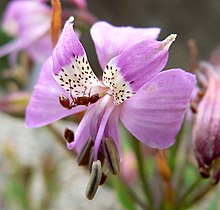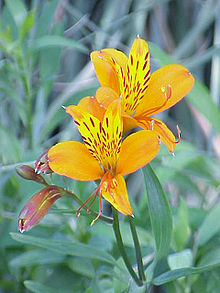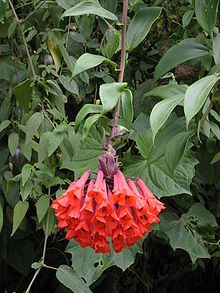| Alstroemerieae | |
|---|---|

| |
| Alstroemeria revoluta | |
| Scientific classification | |
| Kingdom: | Plantae |
| Clade: | Tracheophytes |
| Clade: | Angiosperms |
| Clade: | Monocots |
| Order: | Liliales |
| Family: | Alstroemeriaceae |
| Tribe: | Alstroemerieae Bernh |
| Genus | |
|
(The monotypic genera Schickendantzia and Taltalia have been included within Alstroemeria, the monotypic Leontochir was included in Bomarea) | |
Alstroemerieae is the name of a tribe of monocotyledonous, herbaceous, perennial plants belonging to the Alstroemeriaceae family. They are native to Central and South America. They have very vivid flowers, relatively large and of various colors. Because of the beauty of their flowers, they are often used as ornamental plants and, especially, as cut flowers.
The tribe consists of around 230 species distributed in two genera: Bomarea and Alstroemeria. Until a few years ago, this family was considered part of a broad circumscription of the Liliaceae, but DNA molecular analyses and phylogenetic analyses based on both molecular data as well as morphology and anatomy, have shown that they belong to a separate family.
Description
Herbaceous, erect plants or supporting lianas, with sympodial rhizomes. Some of the roots are thickened and contain starch. The stem is foliose. Leaves are linear to lanceolate or oblong, rather broad in relation to other monocots, entire, narrowing towards the base, usually resupinated, that is, twisted in such a way that the upper surface during its development becomes lower at maturity.
The inflorescences are terminal and umbelliform, forming helical cymes, usually surrounded by a bract involucre, rarely reduced to a single flower.
The flowers are very bright, relatively large, hermaphrodite, trimerous, actinomorphic to slightly zygomorphic. The perigonium consists of 6 free tepals at the base, arranged in two cycles. The color of the flowers can be yellow, red, pink, orange or green, depending on the species and variety; generally with dark spots. They have nectaries at the base of two of the inner tepals. The androecium is formed by 6 stamens, arranged in two cycles, with the filaments free from each other and free from the tepals, narrow, alternating with the pieces of the perianth. The anthers are basifixed, not versatile, with introrse and longitudinal dehiscence. Microsporogenesis is successive and the tapetum is glandular. Pollen grains are sulcate, usually plano-convex and composed of two cells. The gynoecium has an inferoid, trilocular ovary with numerous anatropic ovules with axillary placentation. The fruit is a loculicidal capsule, umbonate or truncate apically, with 6 longitudinal ribs.
The seeds are round or spheroidal, with the embryo small in relation to the endosperm, at maturity with dry tegument in Alstroemeria and sarcotesta in Bomarea.
Calcium oxalate raphides are present in different organs.
Cytology
Diploid Bomarea species have one chromosome pair more (2n=18) than Alstroemeria species (2n=16); however, they have a shorter total chromosome length. Another difference between the two genera is that Bomarea species have more symmetrical karyotypes. Karyotypic analyses on these species indicate that there are considerable karyological differences between the two genera.
Distribution
Bomarea is distributed from central Mexico and the Antilles (24°N) to Argentina (29°S) and Chile (40°S).
Alstroemeria is strictly South American, with species occurring from Venezuela (3°N) to Tierra del Fuego in Argentina (53°S).
Phylogeny and taxonomy
Alstroemerieae is related to Luzuriageae (a tribe with 2 genera and 5 species), native to South America (Luzuriaga) and Australia and New Zealand (Drymophila). The two tribes share vegetative characters such as being vines with resupinate leaves. Both should perhaps be combined into a single family, although APWeb still (January 2009) keeps them separate.
Colchicaceae is also related to Alstroemerieae and Luzuriageae. Some genera of Colchicaceae have twisted leaves, as do Alstroemerieae and Luzuriageae. Petermannia was included in Colchicaceae in APG (1998) and APG II (2003), although it was later determined that this genus (considered a family by APW) is also related to the three families mentioned.
The complete cladogram is given below (APW, updated to January 2009, based mainly on the analysis of Fay et al. 2006, the relationships suggested by the rbcL study of Janssen and Bremer 2004 are quite different, but did not include Petermanniaceae and Corsiaceae):
| Liliales |
| ||||||||||||||||||||||||||||||||||||||||||||||||||||||
The genera of Alstroemeriaceae






Several revisions of Alstroemeriaceae list four genera within the family: Alstroemeria, Bomarea, Schickendantzia and Leontochir, with the addition of the genus Taltalia in 1998. However, the monotypic genera Schikendantzia and Taltalia have been included within Alstroemeria on the basis of detailed morphological, anatomical and chromosomal studies. On the other hand, Leontochir ovallei, the only representative of its genus, has been shown in molecular and morphological analyses to be associated and interbred with Bomarea species, so it cannot be recognized as a separate genus. It was transferred in 2000 to Bomarea, as Bomarea ovallei.
The exact number of species in both genera is difficult to pinpoint exactly since new species are constantly being discovered for science and there are also nomenclatural problems.
- Alstroemeria L., Pl. Alströmeria: 8 (1762). Includes 122 species distributed from southern Venezuela to southern South America. The following names are considered synonyms of this genus:
- Ligtu Adans., Fam. Pl. 2: 20 (1763).
- Lilavia Raf., Fl. Tellur. 4: 35 (1838).
- Priopetalon Raf., Fl. Tellur. 4: 34 (1838).
- Schickendantzia Pax, Bot. Jahrb. Syst. 11: 322 (1889).
- Taltalia Ehr.Bayer, Sendtnera 5: 7 (1998).
- Bomarea Mirb., Hist. Nat. Pl. 9: 71 (1804). Includes 113 species distributed throughout tropical and subtropical America. The following genus names are considered synonyms of Bomarea:
- Vandesia Salisb., Trans. Hort. Soc. London 1: 332 (1812).
- Collania Herb., Amaryllidaceae: 103 (1837).
- Sphaerine Herb., Amaryllidaceae: 106 (1837).
- Dodecasperma Raf., Fl. Tellur. 4: 35 (1838).
- Wichuraea M.Roem., Nat. Syn. Fam. Monogr. 4: 177 (1847).
- Danbya Salisb., Gen. Pl.: 57 (1866).
- Leontochir Phil., Anales Univ. Chile 43: 544 (1873).
Economic and cultural importance
As food
Bomarea edulis is distributed from Mexico to Argentina, its tuberous roots have been used since pre-Columbian times as food. In fact, a well-developed plant can have up to 20 root tubers up to 5 cm in diameter.
As ornamental plants
Some of the alstroemeria species cultivated as ornamental plants are:
- Alstroemeria aurea: native to southern Chile, including Chiloé, it grows in moist undergrowth. It flowers in summer. The plants multiply rapidly thanks to their fine fleshy roots. The stems reach up to 1 m in height. The leaves are lanceolate. The flowers are 3 to 4 cm in diameter, yellow to orange in color and the outer tepals are spotted with greenish tones. For cultivation in the garden, places with moist soil in full sun or partial shade are recommended. It is the most hardy species of the genus, tolerating up to -15 °C if the roots are protected.
- Alstroemeria haemantha: native to Chile, especially in the Valparaiso region. It grows on well-drained rocky slopes. It flowers in early summer. It reaches a height of 1 m and the leaves are glaucous on the underside. The flowers are up to 5 cm in diameter and are red to deep orange. The outer tepals are oblong to obovate. It is resistant to temperatures as low as -15 °C.
- Alstroemeria ligtu: native to Chile, it grows in dry stony and sandy soils. It flowers in late spring and early summer and grows between 60 cm and 1 m tall. The flowers are of various colors, usually lilac and pink, reddish or whitish. In the wild, the flowers of this species are pink but the flowers or plants that are marketed as "ligtu hybrids" are actually the product of a cross between A. ligtu and A. haemantha, obtained by Clarence Elliott in 1927, when he introduced the parental species to England from Chile. In gardens, it is recommended to be grown in well-drained soil in full sun.
- Alstroemeria psittacina is a species that is distributed throughout the Cerrado and Pantanal in Brazil, in Peru and extends southward to the province of Misiones in Argentina. It is a plant about 40 to 60 cm high, with oblong-lanceolate leaves, obtuse at the apex and attenuated at the base. The flowers, 4 to 5 cm long, are arranged in umbels of 5 to 6 flowers. The tepals are red in the lower two thirds, greenish at the apex and spotted. It should be grown in well-drained soil, moist in summer.
- Bomarea ovallei (syn.: Leontochyr ovallei) is a species endemic to Chile that inhabits stony soils, in full sun, in a restricted coastal area of the III region of Chile. It has red flowers, more rarely yellow, gathered in showy inflorescences up to 10 cm in diameter. This species is known as "lion's claw" or "lion's hand". It is an endangered species because of its restricted distribution and because its tubers are food for guanacos and other animals introduced into its natural habitat. It has great potential as an ornamental species.
Hybrid alstroemerias: origin and genetic improvement
Most modern cultivars of alstroemeria do not belong to a particular species but are the result of interspecific hybridization programs. For that reason, modern cultivars, which cannot be ascribed to any particular species, are collectively referred to as Alstroemeria hybrida. The vast majority of modern cultivars, whose breeding was initiated at the Dutch company Van Straaveren in Aslsmeer, are intended to supply the cut flower market. However, some of them can also be used as excellent garden plants.
Originally, these cultivars came from hybridization between Alstroemeria aurea (used in breeding to incorporate strong, tall stems in hybrid cultivars), Alstroemeria pelegrina (its value in breeding programs lies in its large flowers) and A. ligtu (used for their different colors). As the decades passed, many other species were added to these initial three, such as: A. pelegrina alba, A. angutifolia, A. diluta, A. hookeri, A. kingii, A. magenta, A. magnifica, A. pulchra, A. revoluta, and A. werdermannii. There are barriers to hybridization between Alstroemeria species from Chile and those from Brazil. Successful interspecific hybrids have been obtained by in vitro culture of immature hybrid embryos. The cultivars 'Patriot', 'Freedom', 'Redcoat' and 'Liberty' have been produced using this technique. In addition, tetraploids (2n=4x=32) of several sterile hybrids have been successfully produced using in vitro chromosome duplication techniques.
See also
References
- ^ Sanso, A.M.; Xifreda, C.C. (2003), «Flora fanerogámica Argentina: fasciculo 85. 40b. Alstroemeriaceae», Cordoba, Argentina: ProFlora Conicet 14p.-. En Chromosome numbers, Anatomy and morphology, Keys. Geog 4. (broken link available at Internet Archive; see history, first version and latest version).
- ^ Xifreda, C.C.; Sanso, A.M. (1996), «Flora del valle de Lerma: Alstroemeriaceae Dumortier», Aportes Bot. Salta Ser. Flor 4 (7): 11p. (broken link available at Internet Archive; see history, first version and latest version).
- Dimitri, M. 1987. Enciclopedia Argentina de Agricultura y Jardinería. Volume I. Descripción de plantas cultivadas. Editorial ACME S.A.C.I., Buenos Aires.
- ^ Stevens, P. F. (2001 onwards). «Angiosperm Phylogeny Website (Version 9, June 2008, and updated since)». Accessed on January 4, 2009.
- Harling, G.; Neuendorf, M. (2003), «0. Alstroemeriaceae», Flora of Ecuador: 3-108. (broken link available at Internet Archive; see history, first version and latest version).
- Sanso, A.M. (1996), «El género Alstroemeria (Alstroemeriaceae) en Argentina», Darwiniana 34 (1-4): 349-382, archived from the original Archived 2016-03-21 at the Wayback Machine on March 21, 2016. Accessed on December 27, 2008.
- ^ Sanso, A.M. & Juan H. Hunziker. 1998. Karyological Studies in Alstroemeria and Bomarea (Alstroemeriaceae). Hereditas 129, 1: 67-74. DOI: 10.1111/j.1601-5223.1998.t01-1-00067.x
- ^ Sanso, A.M. (2002), «Chromosome studies in Andean taxa of Alstroemeria (Alstroemeriaceae)», Botanical Journal of the Linnean Society 138 (4): 451-459, doi:10.1046/j.1095-8339.2002.00019.x.
- Angiosperm Phylogeny Group. (1998). «An ordinal classification for the families of flowering plants.». Ann. Missouri Bot. Gard. 85: 531-553.
- APG II (2003). «An Update of the Angiosperm Phylogeny Group Classification for the orders and families of flowering plants: APG II Archived 2019-09-28 at the Wayback Machine.» (pdf). Botanical Journal of the Linnean Society (141): 399-436. Accessed on June 6, 2008. (broken link available at Internet Archive; see history, first version and latest version).
- M. W. Chase, unpublished data, cited in Soltis et al. 2005: p.104).
- Fay, M. F.; Chase, M. W., Ronsted, N., Devey, D. S., Pillon, Y., Pires, J. C., Petersen, G., Seberg, O., y Davis, J. I. (2006). «Phylogenetics of Liliales: summarized evidence from combined analyses of five plstid and one mitochondrial loci.». Aliso (22): 559-565.
- Janssen, T.; Bremer, K. (2004). «The age of major monocot groups inferred from 800+ rbcL sequences.». Bot. J. Linnean Soc. 146: 385-398.
- Watson, L.; Dallwitz, M. J. «Alstroemeriaceae». The families of flowering plants: descriptions, illustrations, identification, and information retrieval. Version: 1st June 2007. Archived from the original on April 24, 2006. Accessed on November 4, 2008.
- Bayer, E. (1998), «Taltalia-eine neue Gattung in der Familie der Alstroemeriaceae», Sendtnera 5: 5-14. (broken link available at Internet Archive; see history, first version and last version).
- ^ Lone Aagesen & A. Mariel Sanso. 2003. The Phylogeny of the Alstroemeriaceae, Based on Morphology, rps16 Intron, and rbcL Sequence Data. Archived on February 24, 2016 on Wayback Machine. Systematic Botany Volume 28, Issue 1 pp. 47–69
- Sanso, A. M.; Xifreda, C. C. (2001), «Generic Delimitation between Alstroemeria and Bomarea (Alstroemeriaceae)», Annals of Botany 88 (6): 1057, doi:10.1006/anbo.2001.1548.
- Sanso, A.M.; Xifreda, C.C. (2007), The Synonymy of Schickendantzia with Alstroemeria (Alstroemeriaceae).
- Xifreda, C.C.; Sanso, A.M. (1993), Kew Monocotyledons Symposium.
- Sanso, A.M.; Xifreda, C.C. (1998), Poster presented at Monocots II, Second International Symposium on the Comparative Biology of the Monocotyledons. Sydney. Australia.
- ^ Hofreiter, A. (2006), «Leontochir: A Synonym of Bomarea (alstroemeriaceae)?», Harvard Papers in Botany 11 (1): 53-60, doi:10.3100/1043-4534(2006)112.0.CO;2.
- Ravenna, P.F. 2000. Onira 5: 45.
- Gereau, R.E. (1989), «Three new species of Bomarea (Alstroemeriaceae) from Mesoamerica», Annals of the Missouri Botanical Garden 76 (2): 598-601, doi:10.2307/2399503, archived from the original on November 21, 2018. Accessed on December 27, 2008.
- F. (2005), «Three new species of Bomarea (Alstroemeriaceae) from the Andean region of Colombia», Novon 15: 253-258. (broken link available at Internet Archive; see history, first version and last version)
- Hofreiter, A.; Rodriguez Rodriguez, E.F. (2004), «A new unusual Bomarea species in northern Peru (Alstroemeriaceae)», Arnaldoa 11 (2): 21-28. (broken link available at Internet Archive; see history, first version and last version)
- M.C. (2004), «New Species of Alstroemeria (Alstroemeriaceae) from the Brazilian Savannas», Novon: A Journal for Botanical Nomenclature 14 (1): 17-19. (broken link available at Internet Archive; see history, first version and last version).
- Meerow, A.W.; Tombolato, A.F.C.; Meyer, F. (1999), «Two new species of Alstroemeria L.(Alstroemeriaceae) from Brazil», Brittonia 51 (4): 439-444, doi:10.2307/2666527.
- M. (2000), «Novedades En La Familia Alstroemeriaceae», Gayana Bot 57 (1): 55-59.
- Assis, M.C. (2002), «Novas especies de Alstroemeria L», Rev. Brasil. Bot. 25 2: 177-182. (broken link available at Internet Archive; see history, first version and last version)
- Xifreda, C.C.; Sanso, A.M. (1992), «Bomarea stricta is a synonym of Alstroemeria isabellana (Alstroemeriaceae)», Darwiniana 31: 355-356. (broken link available at Internet Archive; see history, first version and last version).
- De Assis, M.C.; De Mello-silva, R. (2004), «Typifications and a new name in Alstroemeria L.(Alstroemeriaceae)», Taxon 53 (1): 182-184, doi:10.2307/4135510.
- Hofreiter, A.; Tillich, H.J. (2002), «Delimitation, infrageneric subdivision, ecology and distribution of Bomarea Mirbel (Alstroemeriaceae)», Feddes Repertorium 113 (7/8): 528-544, doi:10.1002/fedr.200290005.
- Reference, C.; Van Den Eynden, V.; Cueva, E.; Cabrera, O. (2003), «Wild Foods from Southern Ecuador», Economic Botany 57 (4).
- ^ Phillips, R. y Rix, M. 1991. The Random House Book of Late Perennials. Random House, New York. ISBN 0679 73797 9
- Bridgen, M.P. 1997. Alstroemeria. "n: V. Ball, ed., Ball Red Book, 16th ed., pp. 341-348, Geo. J.Ball Publishing Co., W. Chicago, IL.
- Bridgen, M.P. 1994a. Flowering geophytes of Chile have ornamental potential. Seminario Panamericano de Semillas, p.: 216-230
- Bridgen, M. 2000. Mejoramiento genético del género Alstroemeria. En: Los Geófitos Nativos y su importancia en la Floricultura. Patricio Peñailillo B. and Flavi Schiappacasse C., Eds. Universidad de Talca. pp. 55-63.
- Bridgen, M. 1999. Cultivo de Alstroemeria. En: Seemann, P. y Andrade, N. (Eds.). Cultivo y Manejo de Plantas Bulbosas Ornamentales. Universidad Austral de Chile. Pp. 75-83.
- Bridgen, M.P. 1997. Alstroemeria. En: V. Ball, ed., Ball Red Book, 16th ed., pp. 341-348, Geo. J.Ball Publishing Co., W. Chicago, IL.
- Bridgen, M.P. 1994a. A review of plant embryo culture. HortScience 29(1):1243-1246.
- Chiari, A. y M.P. Bridgen. 2000. Rhizome splitting: A new micropropagation technique to increase in vitro propagule yield in Alstroemeria. Journal of Plant Cell, Organ and Tissue Culture. 62:39-46.
| Taxon identifiers | |
|---|---|
| Alstroemerieae | |